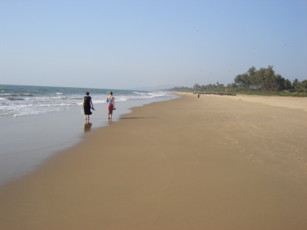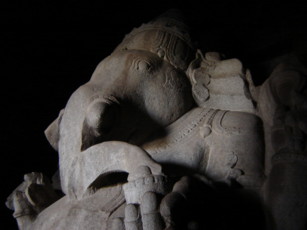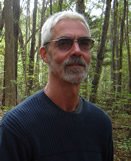Tuesday, January 23, 2007
The Land of the Lotus Eaters
22 January 2007
"After going to all the interesting places in India, there’s no more travel fever. There’s the morning bath, a coffee, a different restaurant every day. And when things get boring, the recreation begins." --a seasoned traveler in India
 It’s the land beyond Goa…now that Goa has become overcrowded even to its southern end, the beach at Palolem--or so I’m told. The old travelers who enjoyed Goa back in the 70s when it was just being discovered by the Beatles, now hang out in Gokarn, an area with a small inconsequential town and a vast beach, 10 kilometers long by 50 to 100 meters wide. As if that weren’t enough space to absorb the meager needs of the minimal tourist population here, there are four more remote beaches nearby--Kudle, Om, Half Moon, and finally, Paradise--that are accessible only by a series of twenty-minute hikes, hopping over a succession of headlands.
It’s the land beyond Goa…now that Goa has become overcrowded even to its southern end, the beach at Palolem--or so I’m told. The old travelers who enjoyed Goa back in the 70s when it was just being discovered by the Beatles, now hang out in Gokarn, an area with a small inconsequential town and a vast beach, 10 kilometers long by 50 to 100 meters wide. As if that weren’t enough space to absorb the meager needs of the minimal tourist population here, there are four more remote beaches nearby--Kudle, Om, Half Moon, and finally, Paradise--that are accessible only by a series of twenty-minute hikes, hopping over a succession of headlands.

 Headlands…an apt phrase, that, considering the state of mind/lessness of a good proportion of the denizens of this zoned-out destination. There are a number of low-key bungalow operations with attached semi-enclosed restaurants at each of the first two beaches, at least. It’s hard to judge the food or the ambience accurately from afar. The social scene ranges from lively conversation by groups of Germans or francophones, to almost eerie silences in some of the other laid-back venues.
Headlands…an apt phrase, that, considering the state of mind/lessness of a good proportion of the denizens of this zoned-out destination. There are a number of low-key bungalow operations with attached semi-enclosed restaurants at each of the first two beaches, at least. It’s hard to judge the food or the ambience accurately from afar. The social scene ranges from lively conversation by groups of Germans or francophones, to almost eerie silences in some of the other laid-back venues.
 I was introduced to the place where I’m staying by a woman from France who’s on her way to a job in the Emirates, via an ashram near Bangalore. We arrived with packs in the pre-dawn darkness after walking through the silent town from the bus stop. The all-night “sleeper” bus was hardly that, bouncing and rumbling over the rough roads from Hampi in the mountains, and depositing us to a nameless location beside the highway at 3:30 in the morning, though the travel agents had told us the trip would bring us to Gokarn at 5:30 in the morning. I asked the other assembled zombies at the unexpected stop where we were, and someone said “a hundred kilometers from Gokarn.” Not to worry, however; in half an hour two mini-buses arrived to take us the last leg to our destination.
I was introduced to the place where I’m staying by a woman from France who’s on her way to a job in the Emirates, via an ashram near Bangalore. We arrived with packs in the pre-dawn darkness after walking through the silent town from the bus stop. The all-night “sleeper” bus was hardly that, bouncing and rumbling over the rough roads from Hampi in the mountains, and depositing us to a nameless location beside the highway at 3:30 in the morning, though the travel agents had told us the trip would bring us to Gokarn at 5:30 in the morning. I asked the other assembled zombies at the unexpected stop where we were, and someone said “a hundred kilometers from Gokarn.” Not to worry, however; in half an hour two mini-buses arrived to take us the last leg to our destination.
 At 60 rupees per night (less than $2), I’ve been content to stay here at the Surya ever since. The first night here I was invited to a jam with a conga player and a tabla player (both with small djembes). I had no drum and very little sleep to go on, but never one to turn down a jam, I came along with my Indian flute, Irish pennywhistle, and plastic shaker. One woman in the party of French people brought along a kitchen bowl. One of the French guys had a sitar. All in all it was a great jam and a further confirmation that the music will come no matter where or when.
At 60 rupees per night (less than $2), I’ve been content to stay here at the Surya ever since. The first night here I was invited to a jam with a conga player and a tabla player (both with small djembes). I had no drum and very little sleep to go on, but never one to turn down a jam, I came along with my Indian flute, Irish pennywhistle, and plastic shaker. One woman in the party of French people brought along a kitchen bowl. One of the French guys had a sitar. All in all it was a great jam and a further confirmation that the music will come no matter where or when.
 The next day I got to talking with an older Britisher with long white hair who likes to play jazz on electric violin. We arranged a breakfast jam this morning with him on guitar and me on flute; we were joined partway along by a woman also staying here who also had a pennywhistle and knew some actual Irish tunes, though she wasn’t used to playing with other people. I had to throw away my own tin whistle this morning because at the nighttime jam the conga player at one point sat on it and squashed it flat--in more than the musical sense.
The next day I got to talking with an older Britisher with long white hair who likes to play jazz on electric violin. We arranged a breakfast jam this morning with him on guitar and me on flute; we were joined partway along by a woman also staying here who also had a pennywhistle and knew some actual Irish tunes, though she wasn’t used to playing with other people. I had to throw away my own tin whistle this morning because at the nighttime jam the conga player at one point sat on it and squashed it flat--in more than the musical sense.
For any fanatics of music theory among present readers, I refer you to a rather esoteric anecdote concerning Indian musical scales as I have been introduced to them.
 And now, a brief recap of my three-day visit to Hampi <click for photo album>. It was the seat of an ancient empire, extending from the late 1300s to the mid 1500s. Its rulers decided to monumentalize their reign in the form of extensive temples and palaces and shrines over an entire mountain plateau, built from great blocks of granite hewn from the local stone that today still dominates the landscape in the form of huge boulders: single ones, odd groupings, whole hills formed of piles of them. The temple architecture is said to impress less from the intricacy of carving found in other sites where carvers used softer schist, than from the sheer size and extent of the building with large pieces of granite. This is true, and yet the beauty of the sculpture that does remain here is all the more impressive as it complements the unfathomable magnitude of the overall building project.
And now, a brief recap of my three-day visit to Hampi <click for photo album>. It was the seat of an ancient empire, extending from the late 1300s to the mid 1500s. Its rulers decided to monumentalize their reign in the form of extensive temples and palaces and shrines over an entire mountain plateau, built from great blocks of granite hewn from the local stone that today still dominates the landscape in the form of huge boulders: single ones, odd groupings, whole hills formed of piles of them. The temple architecture is said to impress less from the intricacy of carving found in other sites where carvers used softer schist, than from the sheer size and extent of the building with large pieces of granite. This is true, and yet the beauty of the sculpture that does remain here is all the more impressive as it complements the unfathomable magnitude of the overall building project.
A few work crews commissioned for current restorations could be seen here and there chipping away at some such blocks for road paving and wall building; and from these firsthand examples it became even more incredible to contemplate how the imperial labor force could have accomplished all its feats in the space of less than 200 years, in this remote and barren landscape.
I explored most of the site on foot, hampered by two main obstacles. My first day there, after a cramped and jolting all-day bus ride from beauty-less Bangalore the day before, I discovered my digital camera was not working; the lens was stuck. Luckily my guest house owners referred me to a bakery where the man was said to repair cameras, and sure enough, I had it back in good working order the next day.
I was ready for a full day of exploration with maps and compass and camera in hand. Unfortunately I miscalculated at a crucial point and found myself wandering far off course through the mountains. Fortunately I was treated along the way to numerous temples scattered here and there, with no other tourist traffic to compete with. A far cry, for example, from the hordes at the Alhambra in Spain, or the Grand Palace in Bangkok.
The most remarkable aspect of that day of hiking for me was the odd sense of déjà vu produced by the arid, boulder-strewn landscape so reminiscent of British Columbian alpine, or even Arctic tundra. That peculiarity was compounded by the presence of these monuments of stone in an otherwise completely wild and God-given setting. It seemed that the dynastic architects had wished to emulate the features of rock they saw around them in this place, and even to work with it and build around it when necessary. The towering temples could be seen as efforts replicate or compete with the natural mountain formations, both crowned as they are with emblems of the ever-present sun.
 My last day in Hampi I was playing my flute in an isolated spot down by the river. A man came nearby and started shaving, then washing his clothes. When he was done I told him that I hoped he didn’t mind the noise I was making with my practice, and I asked him if this was his place, where he lived. No, he said, he was just visiting, too. He was a cloth merchant from Rajasthan, and he sat with me and talked philosophy a while and showed me some core yoga stretches and breathing exercises.
My last day in Hampi I was playing my flute in an isolated spot down by the river. A man came nearby and started shaving, then washing his clothes. When he was done I told him that I hoped he didn’t mind the noise I was making with my practice, and I asked him if this was his place, where he lived. No, he said, he was just visiting, too. He was a cloth merchant from Rajasthan, and he sat with me and talked philosophy a while and showed me some core yoga stretches and breathing exercises.
Like musical opportunities, pieces of enlightenment and meaningful personal connections seem to come unbidden, at the right time.

Wednesday, January 10, 2007
Last Week in Varkala
8 January 2007
It's going to be difficult to leave this place which has become so much like home. I feel far from the pangs of disorientation I experienced on my first arrival in India. If anything, it will be good to get away just for a taste of travel again, as life here has taken on a routine almost too much like home.
Daily drum classes and weekly performances, flute lessons and practice, weekend parties, regular editing work, swimming and long walks each day . . . with quite a familiar type of "alternative community" feeling, except for the fact that everyone smokes cigarettes constantly.
On the subject of fun, and New Year's resolutions, I will interject here a lovely quote about John Steinbeck's lifelong friend and boating companion, biologist Ed Ricketts (from The Log from the Sea of Cortez):
I think he set down his whole code and procedure once in a time of stress. He found himself quite poor and with three children to take care of. In a very scholarly manner, he told the children how they must proceed.
“We must remember three things,” he said to them. “I will tell them to you in the order of their importance. Number one and first in importance, we must have as much fun as we can with what we have. Number two, we must eat as well as we can, because if we don’t we won’t have the health and strength to have as much fun as we might. And number three and third and last in importance, we must keep the house reasonably in order, wash the dishes, and such things. But we will not let the last interfere with the other two.”
So it's on to Hampi (temple ruins) and Goa (more beaches) next week. In the meantime, there's not much new to report, but plenty of photos to share, which is after all a more efficient way to communicate this rich experience.
Archives
January 2006 February 2006 April 2006 May 2006 September 2006 December 2006 January 2007 February 2007 March 2007 April 2007 May 2007 June 2007 October 2007 January 2008 February 2008 March 2008 April 2008 May 2008 October 2008 November 2008 December 2008 February 2009 May 2009 September 2009 October 2009 November 2009 February 2010 March 2010
 Cougar WebWorks
Cougar WebWorks 
 Irregular commentary on various aspects of alternative culture: nature, books, travel, music, literature, spirituality.
Irregular commentary on various aspects of alternative culture: nature, books, travel, music, literature, spirituality.
 Learn djembe and dundun rhythms the easy way
Learn djembe and dundun rhythms the easy way